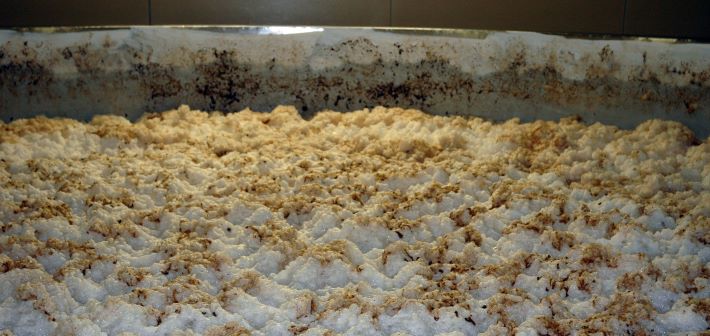
Today’s recipe for Learn to Homebrew Day comes from “For the Love of Hops.” I picked it to remind readers that IPAs are not the only beers that may showcase hops. An added bonus is that I get to include a photo of open fermentation at G. Schneider & Sohn in Kelheim, Germany.
When Schneider released Mein Nelson Sauvin in 2011, brewmaster Hans-Peter Drexel called it the culmination of more than 10 years of brewing experiences.
“I had a crucial experience in the year 2000 when I visited the U.S. for the first time. I found pale ales and IPAs with funky and refreshing notes of citrus and grapefruit,” he said. American brewers explained Cascade hops contributed those aroma and flavors, and shortly thereafter Drexler began experiments using imported Cascade hops and Schneider’s yeast.
He remembered a story brewery owner Georg Schneider VI (who, like his ancestors, is a diploma brewer) told about a special Oktoberfest wheat beer style brewed with a large amount of hops at the Schneider Weisse brewery between 1920 and 1930. The story was, they brewed it at the end of the wheat beer brewing season in April or May. To keep the beer in good condition and safe from infection they used all the hops that remained in their cellars. That beer was called Wiesen Edel Weisse.
Drexler’s experiments with Cascade culminated in Georg Schneider’s Wiesen Edel Weisse, a new version of the wheat beer of the 1920s, with 14 °P, 6.2% ABV, and between 25 and 30 IBU. He described it as “a small revolution on the wheat beer market,” because it had about twice as many bitterness units as any other wheat beer.
“The second step of inspiration happened few years later in 2007 … (when) Garrett Oliver from the Brooklyn Brewery and I launched Hopfenweisse,” he said. “I am sure it was definitely the first dry-hopped wheat beer in Germany, with 40 to 50 IBU.” They used Saphir, at the time quite new, for dry hopping.
Drexler next tweaked the recipes for two standards at Schneider. “The idea was to get more freshness and drinkability to these beers. They should taste funky and balanced. It is not only the hops which works in that way. The malty character and the spiciness or fruitiness show the direction to a balanced and funky taste.”
He replaced Hallertau Tradition and Magnum in Blonde Weisse with 100 percent Saphir and added a bit of Cascade (late hop addition) to Kristall. “The results were amazing,” he said.
That set the stage for Mein Nelson Sauvin. “The idea was to build a bridge from characteristic traditional wheat beer flavors to the wine aroma. (For that) I found Nelson Sauvin hops from New Zealand and yeast from Belgium combined with local wheat and barley malt,” he said. It was the first time Schneider used any yeast other than its own.
“In Germany we have a saying: Tradition does not mean keeping the ashes but carrying on the fire,” Drexler said. “In that sense hops could help to continue the Bavarian tradition of brewing wheat beer.”
Previously: A wit beer recipe ~ A Belgian-style dubbel recipe
Mein Nelson Sauvin
Original gravity: 1.069 (16.8 °P)
Final gravity: 1.013 (3.3 °P)
IBU: 29
ABV: 7.3%
Grain bill:
60% local variety Hermann (6 EBC) wheat malt
20% local variety Marthe (6 EBC) barley malt
20% Urmalz (Munich-style 25 EBC) barley malt
Mashing:
One decoction, targeting high attenuation
Hops:
Hallertau Tradition, 50 minutes (8 IBU)
Nelson Sauvin, 15 minutes (15 IBU)
Nelson Sauvin, 0 minutes (6 IBU)
Boiling: 60 minutes
Yeast: 3 L/hL Schneider yeast from propagation tank. 0.5 L/hL Belgian yeast
Fermentation: 7 days, beginning at 16°C (61°F), allow to rise to 22°C (72°F), reduce to 12°C (54° F)
Bottling: Refermentation in the bottle, using speise (unfermented wort). 3.3 volumes CO2 (6.5 g/L)